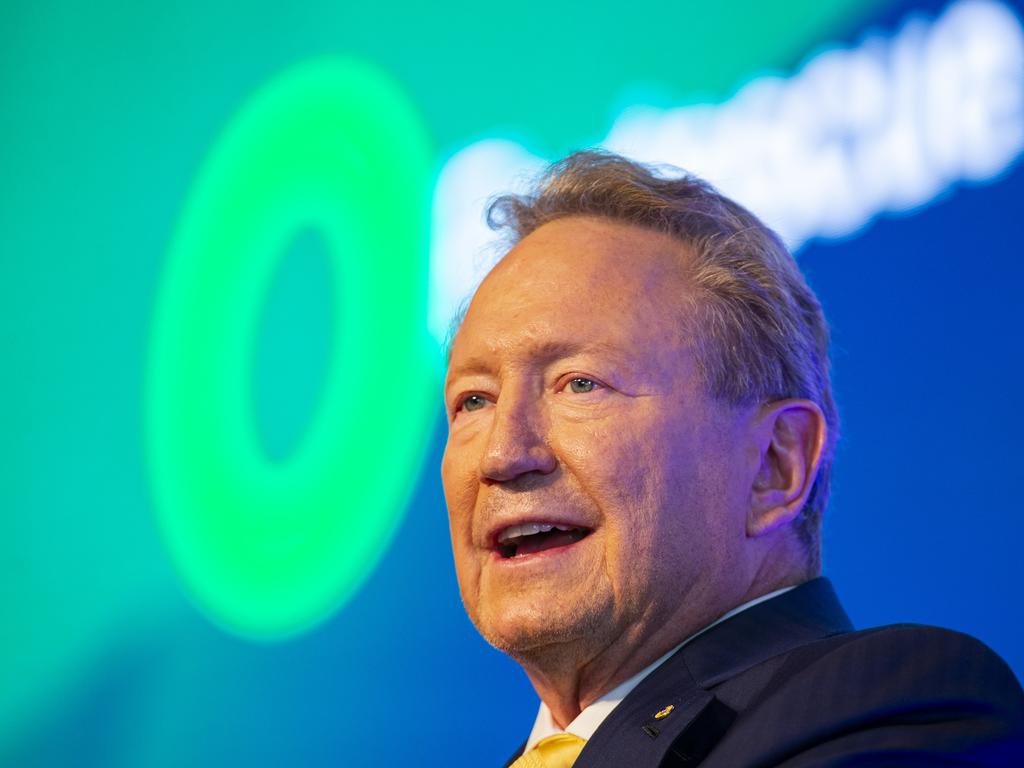Andrew Forrest’s miner acquires 50 electric drills for second solar farm in net zero race to 2030
Fortescue has started work on one of the giant solar farms it needs to turn iron ore mines green and is forking out $350m for electric drill rigs.

Business
Don't miss out on the headlines from Business. Followed categories will be added to My News.
Fortescue will fork out $350m for electric drill rigs at its iron ore operations in Western Australia where it has started work on one of the giant solar farms it needs built to hit net zero emissions by 2030.
The Andrew Forrest-led Fortescue is buying 50 electric drill rigs from Sweden’s Epiroc and has started work on a 190 megawatt solar farm at the Cloudbreak mine.
Cloudbreak will be almost double the capacity of the only solar farm Fortescue has built, and is expected to be operating within two years.
Fortescue has not disclosed the cost of building the solar farm but has said expenditure on renewables assets will come from the $US6.2bn ($9.7bn) it has set aside to reach its decarbonisation target, which includes both scope 1 and 2 emissions.
The Cloudbreak farm is slated to reduce Fortescue’s annual diesel consumption by around 125 million litres.
It is estimated the roll out of the electric drill rigs will cut diesel use by about 35 million litres a year and reduce CO₂ emissions by more than 90,000 tonnes.
Fortescue’s existing 100MW North Star Junction solar farm covers almost 1500 hectares with blocks of solar panels positioned around significant Aboriginal cultural heritage sites.
Perth-headquartered Fortescue is trying to narrow down how much renewable energy and battery storage capacity it will need under plans to stop using diesel and gas by 2030.
Fortescue mining chief executive Dino Otranto said the company would refine its current 2-3 gigawatt target as it rolled out electric haul trucks built in partnership with Liebherr and other electric mining equipment, including the Epiroc drills.
The company has set its sights on building all of the renewable energy assets needed to decarbonise - potentially another 25 solar farms the size of North Star Junction - on its own tenements over the next five years.
However, Fortescue is yet to secure miscellaneous tenements covering about 150,000ha that it applied for in 2023. Fortescue needs to secure the tenements to develop renewables projects under WA’s Mining Act.
Mr Otranto said Fortescue was on track to gain the WA government approvals it needed and working closely with traditional owners.
“Working with government and traditional custodians is front and centre of our decarbonisation plans,” he said.
“Right now we maintain really good relationships. There are no issues or hold ups in the process. It is a respectful process that we’re working through because it is a large land mass.
“The upside of it is that we are not digging any holes. We’re not scarring the landscape, so to speak. These are green power plants that can be used far beyond the mining activities.”
Mr Otranto said Fortescue built the economically-viable North Star Junction solar farm, which supplies the company’s energy-hungry Iron Bridge magnetite operations, around heritage and ethnographic sites, and could do the same elsewhere in the Pilbara.
He said Fortescue might not use all the land covered by the 150,000ha application for wind and solar farms, and to “watch this space”.
The first Epiroc electric drill to arrive at Fortescue’s Solomon mine will be drilling in the next few days.
Epiroc chief executive Helena Hedblom said Fortescue was a leader in reducing emissions in mining and in using automation to strengthen safety and productivity.
“Not only is this the largest contract we have ever received, but it is also a major step forward for our electric-powered surface equipment,” she said.
Fortescue intends to use renewable energy to charge its electric mining machinery.
The company aims to achieve net zero emissions without purchasing carbon offsets, based on a pledge it made in 2023. “Several hundred million dollars” was reallocated to decarbonisation projects in the 2024 financial year which would have ordinarily gone to offsets, Fortescue said in its annual report.
Renewable generation is only one component of the strategy, which will require transmission and distribution and storage.
Fortescue is not the only miner aiming to decarbonise in the Pilbara; gas pipeline owner APA plans to build solar farms and battery storage on big tracts of land it picked up in the $1.7bn acquisition of Alinta Energy’s Pilbara power network. APA has said gas will always be an essential part of the energy mix for Pilbara customers.
More Coverage
Originally published as Andrew Forrest’s miner acquires 50 electric drills for second solar farm in net zero race to 2030





